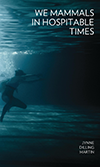And nature looks back
Galway Kinnell’s poem “On the Oregon Coast” centers around a dinner conversation with the poet Richard Hugo on the topic of personification. “We agreed,” Kinnell writes, “that eighteenth- and nineteenth-century poets almost had to personify, it was like mouth-to-mouth resuscitation, the only way they could imagine to keep the world from turning into dead matter.” But in the wake of Darwin’s revelations that man evolved from and with his fellow beasts, Kinnell concludes, poets should “anthropomorphize the world less and animalize, vegetabilize, and mineralize ourselves more.” A noble stance, if a slippery one: ecological thinking still gets shot through with human longing, and can still sink into the murky waters of what Kinnell calls “pre-Darwinian language.” After telling us that Hugo has died, Kinnell concludes his poem with an image of a log “bouncing down the beach” before it “plunges as though for good into the water.” The log stands for Hugo, mineralized—but that means the log is personified, too. Stricken by grief, Kinnell imbues dead matter with extra life, using nature for his own literary purposes.
Reading Jynne Dilling Martin’s We Mammals in Hospitable Times, it is easy to imagine her—given a time machine—zooming back to Kinnell and Hugo’s dinner table. In Martin’s poems, animals, vegetables, and minerals collide and blur and throw one another into relief. She’s interested less in the overwhelming force of Darwin than in the crackling of particulars: polar bears at the zoo wake up in a snowstorm; a biologist drills into a sea snail to hear its heartbeat; a woman marries a worm. As the collection’s title makes clear, Martin animalizes humans—“I dream / of our youthful fucking, our softness, how in ancient times we had tails”—but she also personifies animals and, by their sheer proximity, makes humans and animals resemble one another. “The snake crawling out of her skin pulls it inside out / like a nylon stocking: I wonder who would recognize me now,” she writes. If the “I” is the poet, she’s got some snake in her, too.
To Martin, man is part of nature but also sees it at a distance: in picture books where a “whale battles a horned sea monster,” at a circus where a donkey can “stomp out answers to questions.” Yet humans aren’t the only spectators: “The microscope zooms in on a freshly formed eyeball // gazing expectantly back.” Elsewhere, as the planet warms, “the noise made by a million barnacle larvae swimming north // is less hiss or whisper, more betrayed stare.” We look at nature, and nature looks back. In these moments, Martin puts us in a biological hall of mirrors, or a fun house peopled with polar bears—only instead of a carnival barker outside there’s a street preacher hollering about end-times.
What do those end-times look like? A zoo goes up in flames. A “ship will be crushed in a polar storm.” A pregnant woman is abandoned. “Some animals enter caves and never reemerge.” The most terrifying end-times in We Mammals, though, are still to come: the ice caps will melt; “the mouth of the Beardmore Glacier will spit out [the] bones” of dead explorers; “the basements // of coastal cities will begin to flood, an inch at a time.” Global warming liquefies Martin’s title as well, which can elide into the inhospitable times for which we mammals are responsible.
In 2013, Martin spent six weeks as an Antarctica artist-in-residence, on a grant from the National Science Foundation. There was a flurry of press about her activities, and with good reason: who wouldn’t like stories of a poet among the penguins, donning seven-pound boots and doing yoga out on the ice with scientists? But We Mammals is of a different order: full of quirkiness, affection, and natural beauty, but also of great urgency. Martin reaches her most damning, apocalyptic vision in “Revelations,” in which the world teeters on the brink of ecological collapse and language ceases to work: “Like an adopted cat, your planet hates its name. // Your entreaties bore it and turning, it declines to respond.” Flattery—in the form of scientific study or poetic praise—doesn’t cut it, and the earth plots its revenge for all we humans have done: “no wonder the snow hangs tightly in the sky / ready on a moment’s notice to bury the building where you sit // sketching a future world.”
It’s one thing to look at a log as if it were a person, to imagine oneself as a snake, to remake the world in words. It’s quite another to make the actual world a place where whole species are going extinct, to plot “your jailbreak” from a planet you’ve ruined. That’s why Martin closes “Revelations” by turning the familiar nursery rhyme about a song of sixpence into doomsday prophecy. In the original, four and twenty blackbirds sing for a king. Here Martin gives them the last word, a terrifying one: “Boys, the afterlife will be a pie of live bird heads. / Their song so cracked you won’t dare take a bite.”





